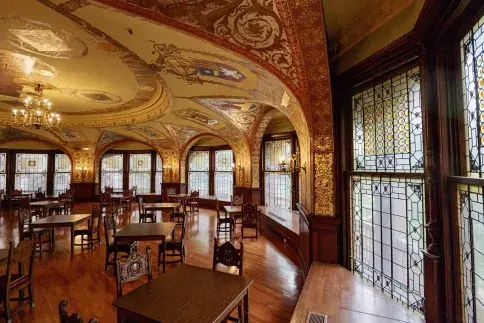Look Up
Decoding D-Hall: Muralists Extraordinaire

George Willoughby Maynard
George Willoughby Maynard
Henry may have been the man with the money, but the one with the vision for these walls (and ceiling) was George Willoughby Maynard.
Education
Born in Washington, DC in 1843, Maynard trained and spent a good deal of his career in New York (as many do), enrolling at the National Academy of Design, where he later became an instructor. He also studied in Belgium at the Royal Academy of Fine Arts. Two of his mentors, Henry Kirke Brown in NYC and Jozef Van Lerius in Antwerp, helped the young artist develop his eye for painting romantic historical scenes.
Inspirations
Maynard traveled around Europe, seeing great works of art and architecture not just in the usual hotspots of France, Italy, England, Greece, and Germany, but in Turkey and the countries of what was then Austria-Hungary, where an assortment of influences brought a different diversity of design. Importantly, he meticulously studied murals, finding inspiration in 15th-century Italian frescoes and the elaborate murals of the recently opened opera house in Paris (now Palais Garnier).
Works
Pre-Ponce
His first architectural work was as an assistant to John La Farge (more on him later) on Boston's Trinity Church, working on murals and stained glass. Maynard painted portraits and interiors for homes, including work in railroad magnate Henry Villard's eponymously named Villard House on Madison Avenue in New York City. Maynard also painted figures representing the Chorus and Ballet within the old Metropolitan Opera House (tragically demolished in 1967).
Post-Ponce
Our own D-Hall seems to have created a niche for Maynard, who went on to design dining rooms for Manhattan's Plaza, Savoy, and Imperial hotels, and a ballroom for the famous Sherry's restaurant. (Only the Plaza still stands.)
At the Library of Congress building, opened in 1897, Maynard painted murals on four themes: Adventure, Discovery, Conquest, Civilization. Does that sound familiar?
Fun Fact
Maynard served as librarian to the National Academy of Design and designed murals for the Library of Congress.
Herman Schladermundt
Herman Schladermundt
Hundreds of hours of artisan work glisten all around you in the Dining Hall. Among the artists who came here to make Henry Flagler’s vision a reality was Herman Schladermundt, a Wisconsin-born, French-trained artist.
Education
He studied at Delecluse and Julian Acadèmies in Paris and was an architect's apprentice in Buffalo, NY.
Works
Ponce
Working alongside George Maynard, Schladermundt added crests and coats of arms to D-hall and the rotunda, as well as bands of celebrating cherubs. While the artists did not sign their individual parts of these walls, these icons are attributed to Schladermundt because they resemble his other known work. During his time working on the Ponce, Schladermundt also refined his stained glass skills, under Maitland Armstrong, working on some of the window designs in the ballroom. WHERE IS THIS LAST FACT FROM?
Post-Ponce
After completing his St. Augustine masterpieces, Schladermundt settled in an artist colony in Bronxville, New York, where Ponce artist Otto Bacher also resided. Schladermundt's work was in high demand. His paintings and stained glass decorated William Rockefeller’s country home in Tarrytown, NY; the Central Congregational Church in Providence, RI; the grand jury room of the Newark (NJ) Courthouse; the corridor of the Denver (CO) Post Office; the Congressional Library in Washington DC; the Missouri State Capitol in Jefferson City; and the Flagler Memorial. (WHERE?)Schladermundt's work received prestigious awards, including a medal at the Chicago Exposition of 1893 and the Allied Arts prize of the Architectural League of New York in 1898.
Fun Fact
Schladermundt designed all 92 stained glass windows in the Memorial Presbyterian Church, the church located across Valencia Street from Proctor Library.